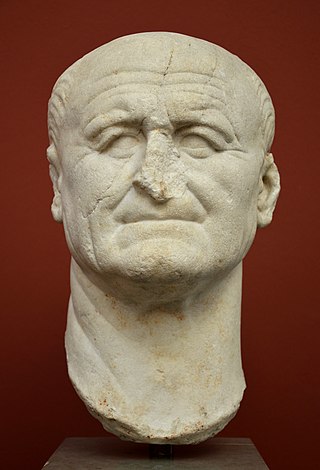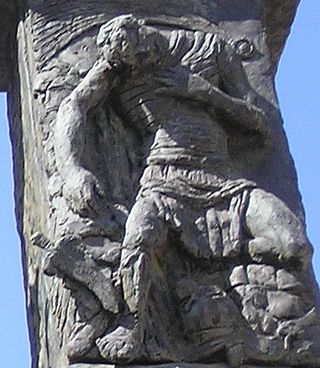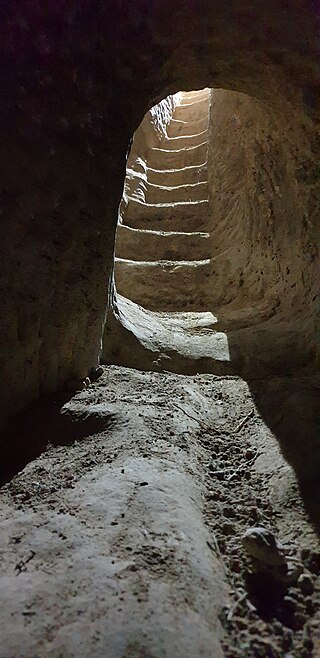
Simon bar Kokhba or Simon bar Koseba, commonly referred to simply as Bar Kokhba, was a Jewish military leader in Judea. He lent his name to the Bar Kokhba revolt, which he initiated against the Roman Empire in 132 CE. Though they were ultimately unsuccessful, Bar Kokhba and his rebels did manage to establish and maintain a Jewish state for about three years after beginning the rebellion. Bar Kokhba served as the state's leader, crowning himself as nasi. Some of the rabbinic scholars in his time imagined him to be the long-expected Messiah of Judaism. In 135, Bar Kokhba was killed by Roman troops in the fortified town of Betar. The Judean rebels who remained after his death were all killed or enslaved within the next year, and their defeat was followed by a harsh crackdown on the Judean populace by the Roman emperor Hadrian.

Vespasian was Roman emperor from 69 to 79. The last emperor to reign in the Year of the Four Emperors, he founded the Flavian dynasty, which ruled the Empire for 27 years. His fiscal reforms and consolidation of the empire brought political stability and a vast building program.
6 was a common year starting on Friday of the Julian calendar. In the Roman Empire, it was known as the Year of the Consulship of Lepidus and Lucius Arruntius. The denomination "AD 6" for this year has been used since the early medieval period, when the Anno Domini calendar era became the prevalent method in Europe for naming years.

The 130s was a decade that ran from January 1, 130, to December 31, 139.
Year 132 (CXXXII) was a leap year starting on Monday of the Julian calendar. At the time, it was known as the Year of the Consulship of Serius and Sergianus. The denomination 132 for this year has been used since the early medieval period, when the Anno Domini calendar era became the prevalent method in Europe for naming years.

Marcus Didius Julianus was Roman emperor from March to June 193, during the Year of the Five Emperors. Julianus had a promising political career, governing several provinces, including Dalmatia and Germania Inferior, and defeated the Chauci and Chatti, two invading Germanic tribes. He was even appointed to the consulship in 175 along with Pertinax as a reward, before being demoted by Commodus. After this demotion, his early, promising political career languished.

Legio II Traiana, was a legion of the Imperial Roman army raised by emperor Trajan, along with XXX Ulpia Victrix, for the campaigns in Dacia. Records of the II Traiana Fortis have been recovered from Egypt dating to the middle of the 5th century. The legion's emblem was the demi-god Hercules.

Syria Palaestina was the renamed Roman province formerly known as Judaea, following the Roman suppression of the Bar Kokhba revolt, in what then became known as the Palestine region between the early 2nd and late 4th centuries AD. The provincial capital was Caesarea Maritima. It forms part of timeline of the period in the region referred to as Roman Palestine.

The Bar Kokhba revolt was a large-scale armed rebellion initiated by the Jews of Judea, led by Simon bar Kokhba, against the Roman Empire in 132 CE. Lasting until 135 or early 136, it was the third and final escalation of the Jewish–Roman wars. Like the First Jewish–Roman War and the Second Jewish–Roman War, the Bar Kokhba revolt resulted in a total Jewish defeat; Bar Kokhba was killed by Roman troops at Betar in 135, and the Jewish rebels who remained after his death were all killed or enslaved within the next year.

Gnaeus Minicius Faustinus Sextus Julius Severus was an accomplished Roman general of the 2nd century. He also held the office of suffect consul in the last three months of 127 with Lucius Aemilius Juncus as his colleague.

The Jewish–Roman wars were a series of large-scale revolts by the Jews of Judaea against the Roman Empire between 66 and 135 CE. The term primarily applies to the First Jewish–Roman War (66–73) and the Bar Kokhba revolt (132–136) which sought restoring Judean independence that was lost since the Hasmonean civil war. Some sources also include the Diaspora Revolt (115–117), a campaign waged by the Jewish diaspora across the Eastern Mediterranean.

Legio X Fretensis was a legion of the Imperial Roman army. It was founded by the young Gaius Octavius in 41/40 BC to fight during the period of civil war that started the dissolution of the Roman Republic. X Fretensis is then recorded to have existed at least until the 410s.

The Kitos War was a Jewish uprising in the province of Judaea during the late 110s CE. Ancient Jewish sources date it to 52 years after Vespasian's war and 16 years before the Bar Kokhba revolt (132–136).

Quintus Labienus Parthicus was a Roman general in the Late Republic period. The son of Titus Labienus, he made an alliance with Parthia and invaded the Roman provinces in the eastern Mediterranean which were under the control of Mark Antony. He occupied the Roman province of Syria together with the Parthians in 40 BC. He then pushed into southern Anatolia, still with Parthian support. The main Parthian force took charge of Syria and invaded Judea. Both Labienus and the Parthians were defeated by Publius Ventidius Bassus, who recovered these provinces for Mark Antony.
Lukuas was one of the leaders of Jewish rebels in Libya during the Diaspora Revolt of 115–117 CE. The narrative of the revolt under Lukuas is told by Eusebius of Caesarea, Michael Syrus, Bar Hebraeus and Cassius Dio, with the latter giving him a quite different Greek name of "Andreas". Very little is known regarding his life and political career beyond these passing references. Eusebius of Caesarea ascribes him the title of "King", leading many later scholars to believe he attempted to assume the title of "King of the Jews" during his political career, but actually there is scarcely any real evidence of a religious connection to that ascribed title.

The Second Temple period or post-exilic period in Jewish history denotes the approximately 600 years during which the Second Temple stood in the city of Jerusalem. It began with the return to Zion and subsequent reconstruction of the Temple in Jerusalem, and ended with the First Jewish–Roman War and the Roman siege of Jerusalem.

Judea or Judaea is a mountainous region of the Levant. Traditionally dominated by the city of Jerusalem, it is now part of Palestine and Israel. The name's usage is historic, having been used in antiquity and still into the present day; it originates from Yehudah, a Hebrew name. Yehudah was a son of Jacob, who was later given the name "Israel" and whose sons collectively headed the Twelve Tribes of Israel. Yehudah's progeny among the Israelites formed the Tribe of Judah, with whom the Kingdom of Judah is associated. Related nomenclature continued to be used under the rule of the Babylonians, the Persians, the Greeks, and the Romans. Under the Hasmoneans, the Herodians, and the Romans, the term was applied to an area larger than Judea of earlier periods. In 132 CE, the Roman province of Judaea was merged with Galilee to form the enlarged province of Syria Palaestina.

The history of the Jews in the Roman Empire traces the interaction of Jews and Romans during the period of the Roman Empire. A Jewish diaspora had migrated to Rome and to the territories of Roman Europe from the land of Israel, Anatolia, Babylon and Alexandria in response to economic hardship and incessant warfare over the land of Israel between the Ptolemaic and Seleucid empires from the 4th to the 1st centuries BC. In Rome, Jewish communities thrived economically. Jews became a significant part of the Roman Empire's population in the first century AD, with some estimates as high as 7 million people; however, this estimation has been questioned.

The Bar Kokhba hiding complexes are underground hideout systems built by Jewish rebels and their communities in Judaea and used during the Bar Kokhba revolt against the Roman Empire. The hiding complexes are believed to have played a significant role during the revolt, particularly in Judea proper. Functioning as hiding places during times of emergency, these systems facilitated defense strategies and guerrilla warfare tactics. Researchers distinguish among the concealment complexes between those constructed in conjunction with the revolts, which include hiding complexes and cliff shelters, and a different category, the natural refuge caves used as ad hoc hiding places toward the end of the wars.

El-Jai cave is a sizable karstic cave located in a cliff within the northern Judaean Desert, in the modern-day West Bank.
















